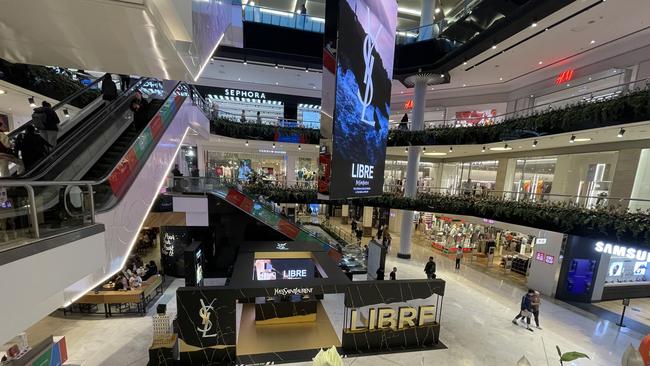RBA’s next move in the spotlight after figures reveal a retail slump
Economists are debating whether the Reserve Bank will stop lifting interest rates any sooner.

Aggressive interest rate rises may be starting to hit consumer discretionary spending.
Economists are debating whether the Reserve Bank will stop lifting interest rates any sooner after a much bigger-than-expected fall in December retail sales in seasonally adjusted terms.
The RBA’s interest rate decision and outlook statement after next week’s meeting are complicated by changing year-end spending patterns and higher-than-expected underlying inflation.
Market pricing on the peak cash rate fell to 3.75 per cent from 3.85 per cent, and the market-implied chance of another 25 basis point rate increase by the RBA in February, slipped to 76 per cent after retail sales fell 3.9 per cent on-month versus consensus estimates of about minus 0.3 per cent.
The Australian dollar fell 0.5 per cent to a five-day low of US70.20c as bond yields dipped.
The sharemarket closed flat after hitting a fresh nine-month high following the retail data.
The fall in nominal retail sales was the fourth largest on record, or the second largest, if Covid-19 lockdown-affected falls in April and August 2020 are excluded.
The only larger fall came in July 2000 when the GST was introduced.
ANZ said strong Black Friday sales and a shift to travel spending in late 2022 hit retail sales, but the extent of the fall suggests households started to cut back on discretionary spending.
The fall in retail sales exceeded that of the past two Decembers, even though 2020 and 2021 saw significantly bigger gains in Novembers, said ANZ economists Madeline Dunk and Adelaide Timbrell.

Sales fell the most across discretionary goods categories, and the falls in household goods retailing, fashion retailers and department stores, in their opinion were “too sharp to be shrugged off by a concentration of end-of-year spending into November.”
Those groups respectively fell by 7.8 per cent, 13.1 per cent and 14.3 per cent on-month.
ANZ sees consumption growth slowing through 2023 as a result of higher interest rates and the recent decline in real wages, due to very strong inflation.
But the RBA can’t afford to stop tightening yet, according to Citi.
A “large pull forward” of retail spending by households into November from the Black Friday discounting window “sucked the oxygen from retail spending in December”, said Citi Australia chief economist Josh Williamson. The RBA has raised to cash rate to 3.1 per cent from 0.1 per cent.
December’s 3.9 per cent fall “may also signal that households are responding to higher official interest rates”, but this is “unlikely to stop the RBA from announcing another 25 basis point hike next Tuesday, Mr Williamson said.
He expects the cash rate to hit a high of 3.85 per cent in the June quarter.
While the ABS said some of the fall in December retail sales was also likely a response from households to high cost-of-living pressures, retail trade in original terms rose 16 per cent on-month.
Yet this was outweighed by seasonal adjustment, something that doesn’t yet fully account for the Black Friday sales period, and the weakness in December was solely related to spending categories that were boosted by Black Friday sales in November.
“At 3.10 per cent, the cash rate is only marginally restrictive and the fourth-quarter CPI result signalled that inflationary pressures are continuing to expand, and that the peak for inflation is likely to be further into the future,” Mr Williamson said.
He expects the RBA to lift its June 2023 headline inflation forecasts to 6.8 per cent from 6.3 per cent and also lift its trimmed mean forecast to 6 per cent from 5.4 per cent.
Headline inflation rose 7.8 per cent on-year in December.
“Consumers also have a large pool of savings to draw on, with solid labour demand expected to deliver strong employee compensation growth,” Williamson said.
“This should buttress household consumption growth in the short to medium term.”
However, AMP Capital said the retail sales data increased the chance of no change in rates next week.

The RBA “may be concerned that interest rates have been tightened too much, which risks a serious downturn (or) recession and rate cuts later on”, said AMP Capital senior economist, Diana Mousina.
She expects the RBA to increase the cash rate by 0.25 per cent at next week’s meeting because the inflation data – particularly the trimmed mean – would be above the central bank’s liking and “risks entrenching higher inflation for longer in Australia.”
Trimmed mean CPI rose 6.9 per cent on-year in the December quarter, exceeding the RBA’s forecast.
“Either way, we expect the RBA’s communication to indicate that holding the cash rate steady will be the likely policy course after the February meeting and today’s data confirms that a February hike will probably be the last for this cycle,” Ms Mousina said.
The Australian Bureau of Statistics said the large fall in December retail sales suggested spending was slowing due to high cost-of-living pressures, as retail businesses reported that many consumers responded to these pressures by doing more Christmas shopping in November to take advantage of heavy promotional activity and discounting as part of the Black Friday sales event.
BetaShares chief economist David Bassanese said that while a sharp curtailment of consumer spending due to higher interest rates and weaker house prices continued to be the major downside risk for the economy this year, some slowing in spending was expected and likely to be welcomed by the RBA.
“It will also likely want to see a run of soft consumer spending numbers before it could be convinced households are really starting to pull in their reins, and are not just shifting spending from one month to the next,” Bassanese said.




To join the conversation, please log in. Don't have an account? Register
Join the conversation, you are commenting as Logout